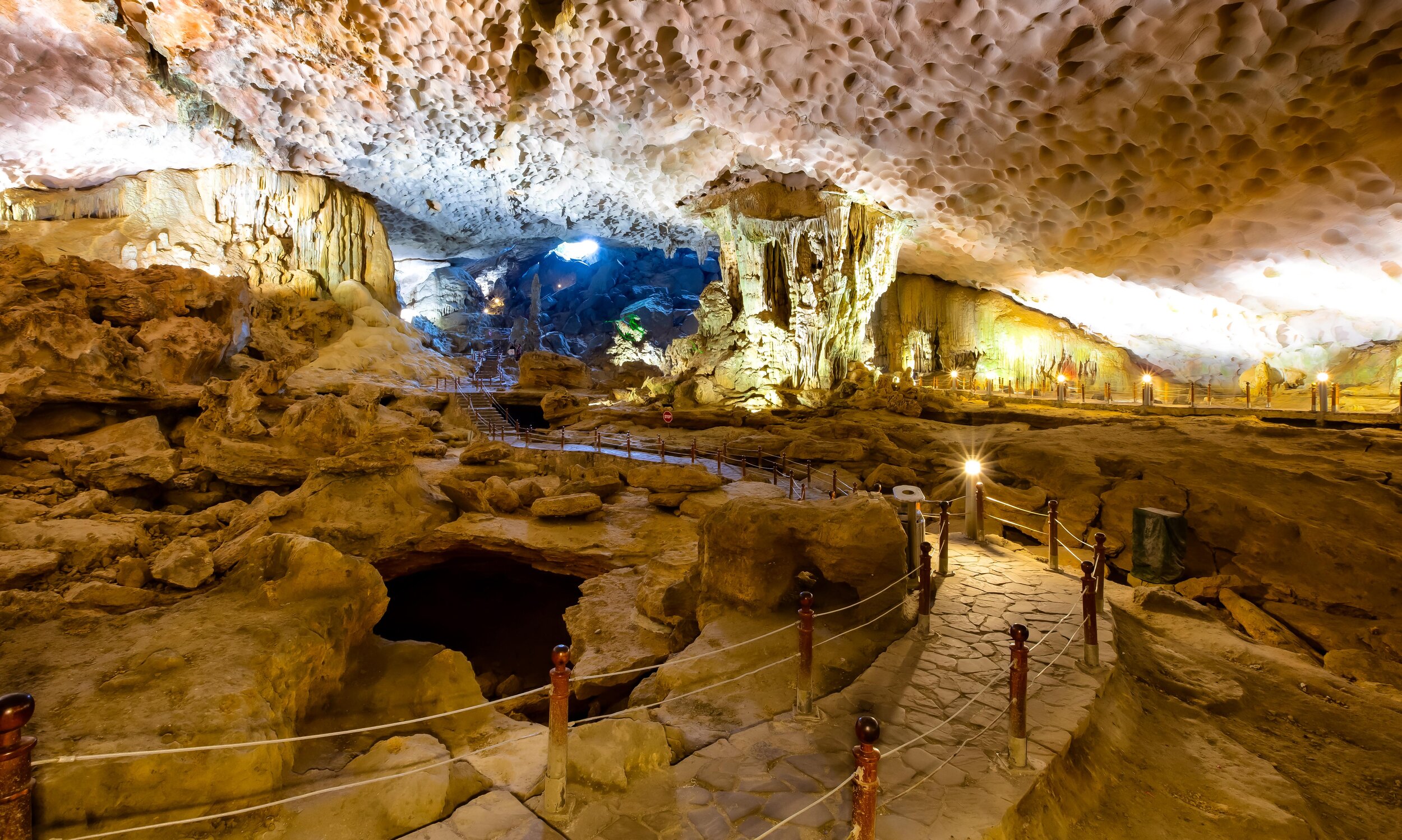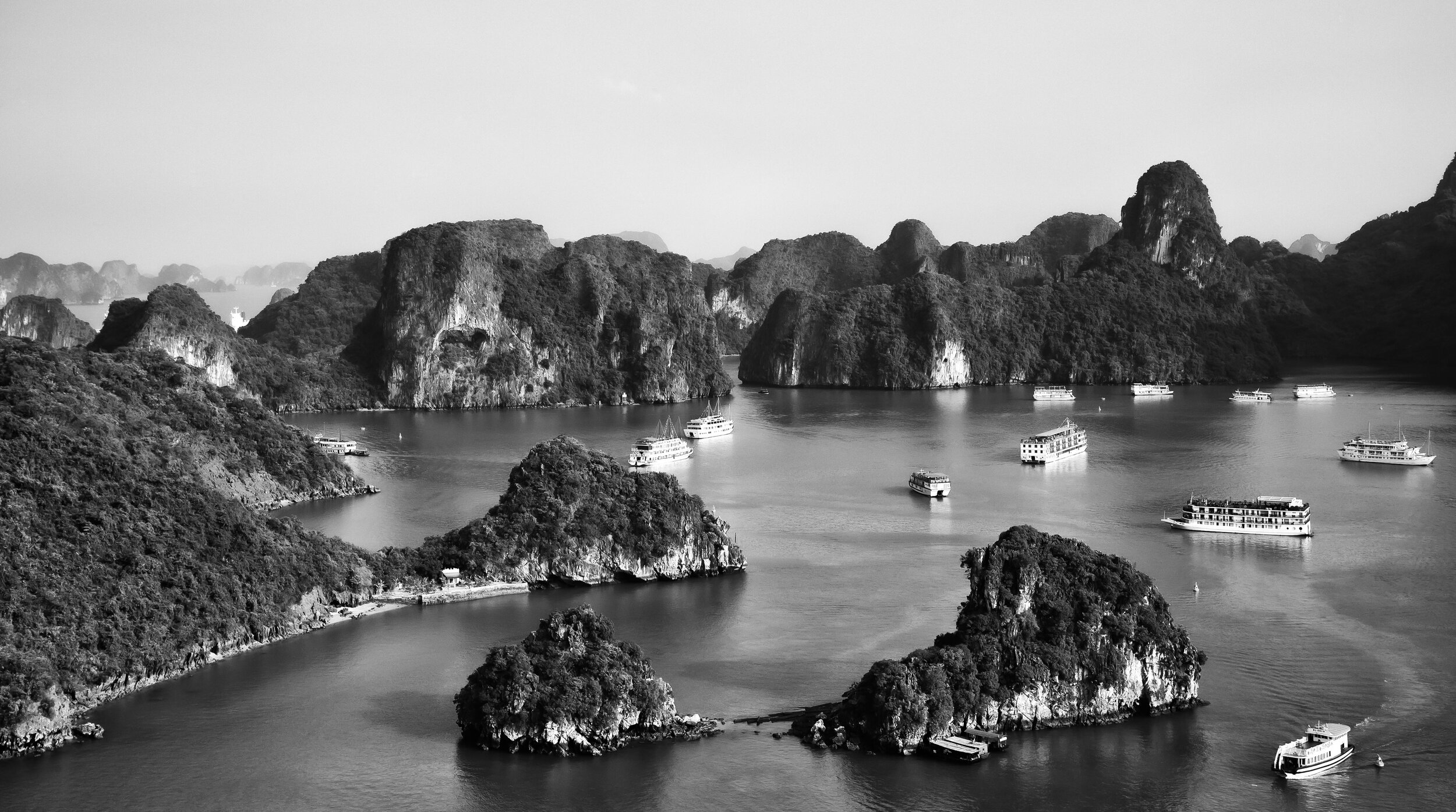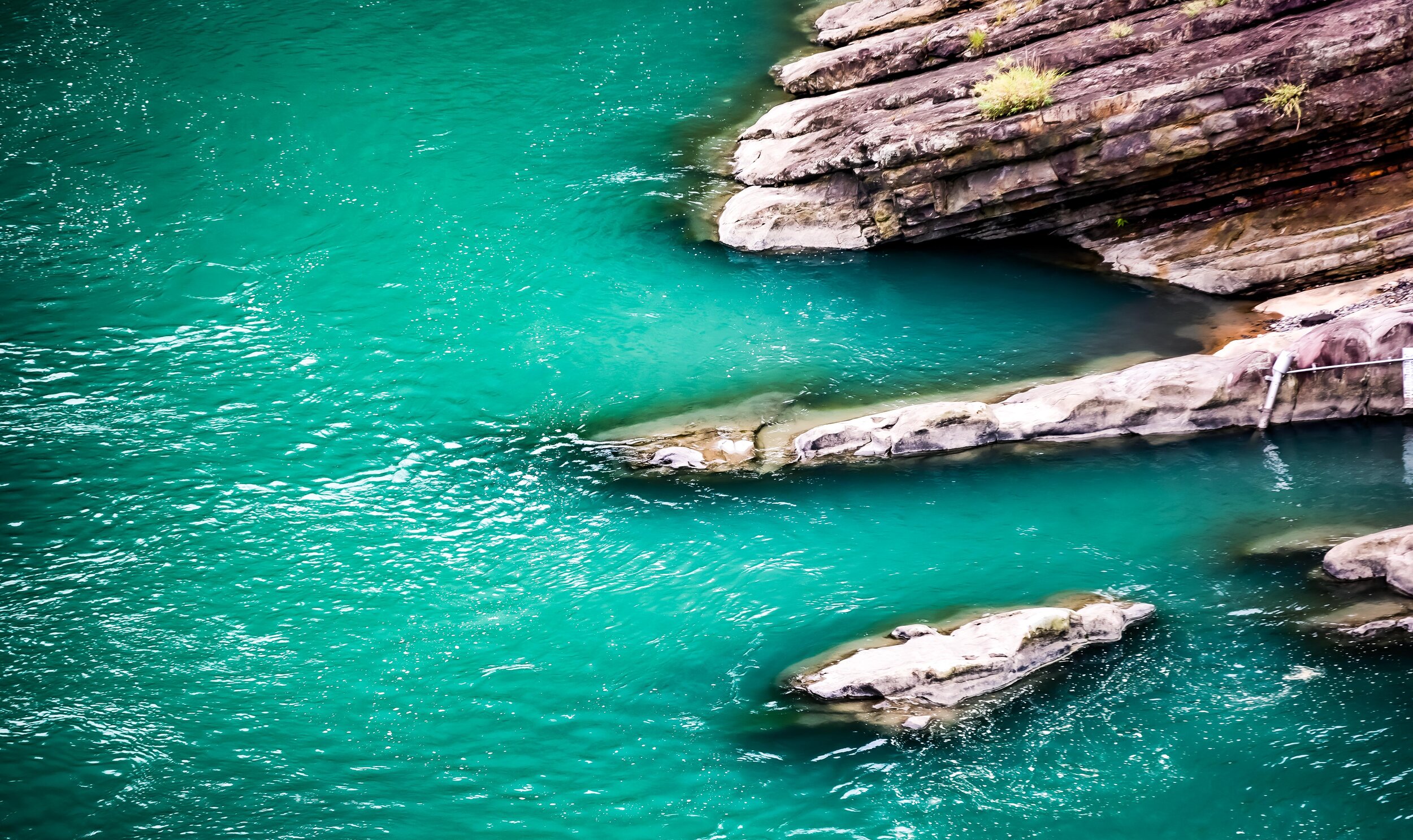Let’s be real.
You can’t really take a trip to Vietnam without having visited its number-one attraction.
Could you actually return home to your friends and family and proudly tell them about your adventure without a story or two about its magnificent Halong Bay?
Sure, you might argue that there are about a million things to see, do and more importantly - eat - when you’re in Vietnam, but the consensus these days is that if you haven’t spent a day or two touring Halong Bay, you’ve missed out.
I suppose it would be a bit like visiting Paris and not checking out the Eiffel Tower.
Why is Halong Bay considered Vietnam’s number one tourist destination?
Well, probably because it is literally home to thousands of towering limestone pillars and islets that rise up out of the emerald-green waters creating an unmatched ethereal beauty.
The jaw-dropping natural beauty that you’ll discover while cruising through the bay is an experience that every world traveller should want to experience.
Which is why it has been designated as a UNESCO World Heritage Site, has become one of the most popular tourist destinations in South East Asia and also a huge tourist trap.
Hạ Long Bay
According to local legends, Vietnam’s early history was quite similar to what has taken place over the past few centuries - Under constant threat of invasion from all sides, the people had to be constantly prepared for battle.
Fortunately they were able to call for the assistance of a family of dragons to protect them.
Appearing in the sky, instead of breathing fire and murdering everyone, the dragons began spitting out pieces of jewels and jade, which miraculously transformed into islands and islets in the bay that formed a great wall against the invaders.
Having a couple thousand islands rise up out of the sea obviously had a detrimental effect on the invading navy, whose ships all crashed and sank.
Content with their effort (and their creation), the dragons decided to stick around and make their home in the bay.
Thus the name, Vịnh Hạ Long (下龍灣), which translates as ‘Descending Dragon Bay.’
Located in northeastern Vietnam’s mountainous Quảng Ninh Province, Halong Bay has a total area of around 1,553 km² and consists of anywhere between 1,960 - 2,000 (mostly uninhabited) and undisturbed islets, which have taken around 500 million years to form into the beautiful landscape that we are able to enjoy today.
Halong Bay is home to thousands of iconic towering limestone karst islets, impressive caves, beaches, floating villages and impressive bio and geo-diversity that has been crafted by nature over the past twenty million years.
Thanks to the effort of those legendary dragons, the bay is also home to fourteen endemic species of flora as well as over sixty species of fauna.
While there is evidence of prehistoric human settlements in the area, today Halong Bay is home to a community of about 1,600 people spread between four different floating fishing villages where fishing and aquaculture are their main source of income.
If you were counting, there are actually more islands in the bay than there are inhabitants.
Coincidentally the inhabitants of the area often have little to do with the massive tourism that takes place in the bay, but their livelihoods are affected by the pollution caused by mass-tourism, so while efforts are being made to clean the bay up, there has also been a focus on helping to improve their lives.
Located in a tropical environment, Halong Bay more or less only has two seasons: A hot and wet summer and a dry and cold winter with an average temperature ranging from 15-25 degrees.
This doesn’t necessarily mean that there is an optimal time to visit the bay as both the summer months and the winter months are equally comfortable but there are pros-and-cons with regard to the time of the year you plan on visiting, so I recommend checking out the link below so you know what to expect when you visit.
Link: When is the Best Time to Visit Halong Bay? (Indochina Odyssey Tours)
While all of the attention that Halong Bay receives from travelers is well-deserved, in recent years questions have arisen with regard to ‘ethical tourism’ as the area has been over-run with tourists (an estimated 5,500 tourists per day), who contribute (whether consciously or not) to a considerable amount of pollution as well as damage to the natural environment.
This has led to scathing reviews online with many travelers complaining about their negative experiences due to the pollution that has transformed the beautiful emerald green waters into a stinky brown colour with solid waste floating all over the place.
Fortunately, this is something that local NGOs and the Vietnamese government have started to take seriously.
Currently, it is estimated that several thousand tons of trash (yes, you heard that right) is collected from the bay on a daily basis. This is in part the fault of mass-tourism, but also due to solid waste floating through the Gulf of Tonkin and eventually settling within the coves in the bay - nevertheless, it’s a tremendous amount of garbage.
This has prompted the government to start looking at long-term sustainable solutions to solve the bay’s pollution issues - Over the past five years the provincial and national governments have worked together to come up with plans to institute bans on the use of plastic in the area.
They’ve also required tour boat operators to retrofit their cruise-boats with more safety equipment as well as better waste treatment facilities.
Likewise, the International Union for Conservation of Nature (IUCN), a Non-Governmental Agency (funded by USAID) has taken the lead to help lobby the government, businesses and civil society to get the ball rolling on the hard work needed to help clean the bay.
They’ve also worked to help educate the local population and increase awareness of the issues, enact policies at the local and national level and even coordinates clean-up days.
One clean-up in general shocked local residents when it was reported that volunteers removed more than 750 kilos of trash within an hour of starting their clean-up.
Link: Halong Bay to pilot plastic ban on tourism boats (VNExpress)
When I announced that I’d be visiting Halong Bay, one of my friends told me that I ‘probably shouldn’t expect too much’ as the bay was extremely polluted.
I’m happy to report that even though the signs of pollution and over-crowding are visible, its also obvious that an effort is being made and that the local people are taking part in the cleanup as I saw several boats on the bay with people collecting floating garbage around the many coves.
So, the question a lot of people ask themselves is whether or not you can be an ethical tourist and still visit Halong Bay?
If you’re asking me, I think if you take some time to ensure that your tour is one that adheres to the current environmental standards put in place by the government, then it shouldn’t be much of an issue.
There are questions that you should be asking before booking your tour and you’ll want to make sure that they’re not just paying lip service to attract your business.
That being said, yes, there is still a lot of work to be done to clean up the bay and to ensure that it stays clean, but these are issues that are being addressed (albeit slowly) but it seems like Vietnam is searching for sustainable solutions to preserve the natural environment, which is good news for Halong Bay, and all the tourists who’d love to visit.
You’ll find quite a few travel blogs that will recommend you don’t visit and many of them have valid arguments as to why you shouldn’t. Personally though, I had a great time and I’d certainly recommend others to visit as well - especially since your tourist dollars will help to contribute to the cleanup of the area.
Sung Sot Cave
With thousands of towering pillars rising out of the Gulf of Tonkin, Halong Bay is home to a wide variety of ancient geology that dates back as far as the Cambrian Period (570,000,000 - 500,000,000 BC).
In 2000, when the UNESCO World Heritage Committee confirmed Halong Bay as one of the locations added to their list of heritage sites, they noted that Halong Bay is an “outstanding example, representing major stages of the Earths history and its original limestone karstic geomorphologic features”.
The formation of Halong Bay took place millions of years ago in the deep sea with tectonic shifts drastically changing the topography of the area and eventually pushing many of the limestone pillars out of the sea. This, in addition to millions of years of erosion, a warm climate and other factors contributed to the beautiful landscape that we can enjoy today.
One of the various changes to the landscape on the various islets in the bay over this long period of time was the formation of caves.
Halong Bay is home to some really spectacular caves that are often included on the tours, but the actual number of caves in the area remains a mystery as the majority of them are still underwater.
None of the caves discovered thus far though are as large or as popular as Hang Sung Sot, otherwise known as the “Cave of Surprises”, which was discovered in 1901 by the French.
Located on Bon Ho Island, a jetty wharf has been set up on the beach and includes a set of stairs to the entrance of the cave as well as a well-lit pathway inside.
The popularity of the cave isn’t just because of its accessibility, it is thanks to its massive size with chambers large enough to hold thousands of people and is also home to thousands of stalactites and stalagmites.
Touring the Cave of Surprises is a breathtaking and humbling experience as the 10,000 square meter cave (30 meters in height, 500 meters long) is home to a number of geological treasures with a few in particular that your tour guide will tell you looks like a Buddha, a large tortoise and another a cannon (but actually looks like a penis).
The large chambers are naturally lit, but there are also cleverly placed lights that illuminate most of the important aspects of the cave that your tour guide will want to point out.
When you’re in the cave it is easy (for those with an imagination) to see images in the rocks of those of animals, but for myself, I was amazed at the sheer size of the main chamber and the ceiling which looked somewhat like the surface of moon, which was enough to send my imagination off to the races.
If you’re planning a trip to Halong Bay, I highly recommend that you make sure that a trip to the ‘Cave of Surprises’ is included on your itinerary as it is an awe-inspiring experience.
Link: Sung Sot Cave: The ‘Surprising’ Story behind Halong Bay’s Largest Cave (Halonghub)
Touring Halong Bay
Do you have your own sailboat?
If so, you’ll be able to enjoy Halong Bay at your leisure!
If you’re like the rest of us though, Halong Bay, Vietnam’s number one tourist attraction is going to have to be enjoyed with the help of a boat cruise and guided tour.
With a multitude of tours to choose from though, visiting Halong Bay can often be a bit daunting for tourists as choosing the right tour can take hours of research.
When considering a tour package, there are a number of things that you’ll want to keep in mind before making your decision.
The first, obviously is your budget - How much you are willing or able to spend on a tour of Halong Bay will affect how much you’re going to see and do as well as the quality of the cruise ship you’ll be on.
Link: Choosing a Halong Bay Tour - Why is it so hard? (Time Travel Turtle)
The next thing you’ll want to consider is how much time you’re willing to spend enjoying the beauty of Halong Bay.
Vietnam is a large country and there is quite a bit to see and do, so it is important to plan carefully so that you can make the most of your trip and also enjoy the Generally there are three types of tours to choose from: 3-day, 2-night, 2-day, 1-night or a quick single day sightseeing tour.
When considering your tour, its important to remember that getting to Hai Phong Harbour from Hanoi usually takes about 3-4 hours (depending on traffic), so if you’re planning on doing the one-day sightseeing tour out of Hanoi, you’re going to have to spend almost eight hours sitting on a bus, which if you ask me is a complete waste of your day.
If on the other hand you choose to spend a few days in the area, you can take advantage of one of the many all-inclusive packages.
Once you’ve decided how long you’re going to spend in Halong Bay and what your budget is, you’re going to have to decide what kind of experience you’re looking for.
There are various cruise ships take different routes through the bay and offer a variety of different activities both on and off the boat.
You’ll also discover that many of the boats cater to specific crowds.
If you’re looking for a backpackers experience, there’s something for you. If you’re looking for a party on the bay, you’ll definitely find what you’re looking for. Likewise, if you’re taking grandma and grandpa and the rest of the family on a trip, there’s also something for them to enjoy.
Some of the activities the various cruise ships offer may include:
Swimming
Cave Exploration
Kayaking
Hiking
Snorkeling
Squid Fishing
Tai Chi / Yoga
Cooking classes
Visiting floating villages
Beach BBQ
While the off-boat activities involved are an important part of your decision, you’re also going to want to read reviews of the different cruise ships, look at photos and do some research into the food and accommodations that will be available on your trip.
You’ll also want to find out how old the boat is, what facilities are available on board, how many people will be included on the tour, etc.
Link: Halong Bay: How to Choose the Best Cruise in 6 Easy Steps (Geeky Explorer)
When you arrive in Hanoi and you’re walking around the beautiful streets of the city, you’ll undoubtedly come across hundreds of signs advertising tours of Halong Bay.
Although it may seem convenient to book your tour directly to barter for a better price, I can’t caution you enough that this is usually not a very good idea. If you take this route, you’ll likely end up paying more for less and you won’t be able to do the research necessary to ensure that your trip will have the experience that you were hoping for.
Likewise, if you’re staying in a hostel or hotel and they offer tour packages, its probably best not to pay too much attention to them as they’re probably marked up considerably in price and lacking in quality.
I completely understand that the amount of resources online about touring Halong Bay can be overwhelming, but you’ll be doing yourself a favor if you read a few reviews and do some research before committing to spending money.
And yes, as mentioned above, ‘eco-travel’ and ‘ethical tourism’ is important when considering your choice for a tour of Halong Bay.
If you want to enjoy the beauty of the area and want to contribute to the effort to preserving it for future generations, you’ll want to keep your eye out for companies that operate with an association or partnership with the following organizations:
For your consideration the following are two of the most highly recognized tour groups that offer eco-friendly tours of Halong Bay:
For most general searches and to compare prices and rates check the following sites:
And if you’d like to splurge and check out Halong Bay from the air, you’ll want to check out Hai Vu Aviation for one of their tours.
There are about 1,960 reasons why you should include a visit to Halong Bay on your travel itinerary if you’re visiting Vietnam.
I realize that you’ll find a wealth of conflicting information on the internet as to why you should or shouldn’t visit - and I don’t refute any of their claims.
There are definitely numerous arguments on both sides and a long list of pros and cons.
Still, I had a great time with very few complaints and I’m sure that most tourists feel the same.
The environmental situation however is a major issue and is definitely something that needs to be seriously improved so that the bay can retain its breathtaking beauty and its not ruined in an unsustainable grab for tourism dollars.
If you visit, it’s important that you do your best to practice ethical tourism and try not to exacerbate the issue. It has taken millions of years to craft Halong Bay into the breathtakingly beautiful landscape that it is today, so let’s do our best not to ruin it with a couple decades of tourism.

































































